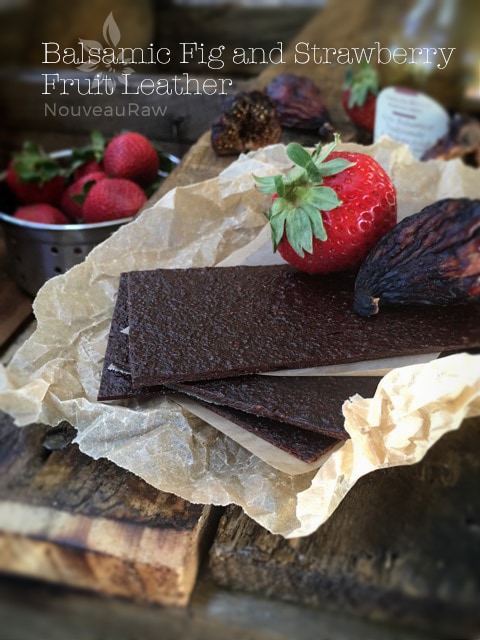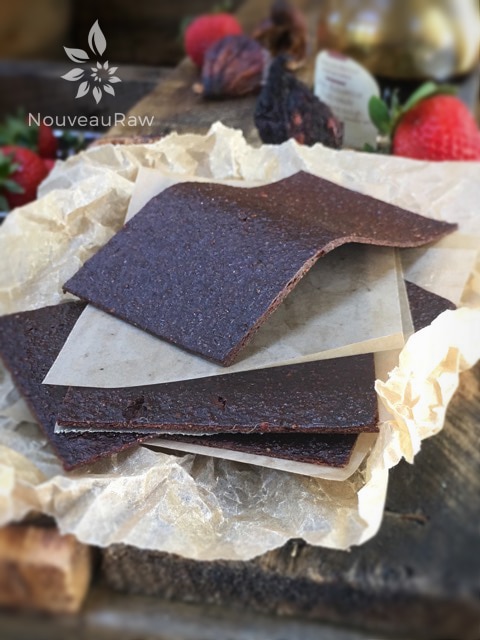Balsamic Fig and Strawberry Fruit Leather

 Add to favorites
Add to favorites

~ raw, vegan, gluten-free, nut-free ~
You can find dried figs throughout the year, but there is nothing like the unique taste and texture of fresh figs.
They are lusciously sweet with a texture that combines the chewiness of their flesh, the smoothness of their skin, and the crunchiness of their seeds.
Sounds like a party for the taste buds! California figs are available from June through September; some European varieties are available through autumn. Though we have to act fast to get our hands on them, it is well worth it.
Fresh figs are a true delicacy and offer many health benefits:
- Good source of fiber; they offer more fiber than any other fruit. The fiber in figs is good for digestion and is known to help prevent colon cancer.
- Figs are high in calcium helping to promote bone density.
- Pectin, a soluble fiber, in figs helps to lower cholesterol.
- Potassium in figs helps to maintain blood pressure.
- Vitamin A, C, E, and carotenoids in figs protect against age-related macular degeneration the disease that destroys vision.
- Manganese is necessary for the metabolism of carbohydrates and amino acids.
- Potassium helps to regulate the homeostasis of the body’s fluids, water, and acid-base balance.
Want to give your taste buds a happy dance?! The combination of sweet strawberries, the earthiness of the fig, and the warmth of the balsamic will cause a standing ovation in your mouth. Well, don’t take my word for it, give it a try and let me know what you think.
 Ingredients:
Ingredients:
yields 4 cups puree
- 3 cups fresh organic strawberries
- 2 cups fresh figs
- 1 Tbsp real balsamic vinegar
- 1/2 tsp Himalayan pink salt
Preparation:
- Select RIPE or overly strawberries and figs that have reached a peak in color, texture, and flavor.
- Puree the fruit, vinegar, and salt, in the blender or food processor until smooth.
- Taste and sweeten more if needed. Keep in mind that flavors will intensify as they dehydrate.
- When adding a sweetener do so a little at a time, and reblend, tasting until it is at the desired taste.
- It is best to use a liquid type sweetener. Don’t use granulated sugar because it tends to change the texture.
- Spread the fruit puree on teflex sheets that come with your dehydrator. Pour the puree to create an even depth of 1/8 to 1/4 inch. If you don’t have teflex sheets for the trays, you can line your trays with plastic wrap or parchment paper. Do not use wax paper or aluminum foil.
- Lightly coat the food dehydrator plastic sheets or wrap with a cooking spray, I use coconut oil that comes in a spray.
- When spreading the puree on the liner, allow about an inch of space between the mixture and the outside edge. The fruit leather mixture will spread out as it dries, so it needs a little room to allow for this expansion.
- Be sure to spread the puree evenly on your drying tray. When spreading the puree mixture, try tilting and shaking the tray to help it distribute more evenly. Also, it is a good idea to rotate your trays throughout the drying period. This will help assure that the leathers dry evenly.
- Dehydrate the fruit leather at 145 degrees (F) for 1 hour, reduce temp to 115 degrees (F) and continue drying for about 16 (+/-) hours. The finished consistency should be pliable and easy to roll.
- Check for dark spots on top of the fruit leather. If dark spots can be seen it is a sign that the fruit leather is not completely dry.
- Press down on the fruit leather with a finger. If no indentation is visible or if it is no longer tacky to the touch, the fruit leather is dry and can be removed from the dehydrator.
- Peel the leather from the dehydrator trays or parchment paper. If it peels away easily and holds its shape after peeling, it is dry. If it is still sticking or loses its shape after peeling, it needs further drying.
- Under-dried fruit leather will not keep; it will mold. Over-dried fruit leather will become hard and crack, although it will still be edible and will keep for a long time
- Storage: To store the finished fruit leather…
- Allow the leather to cool before wrapping up to avoid moisture from forming, thus giving it a breeding ground for molds.
- Roll them up and wrap tightly with plastic wrap. Click (here) to see photos on how I wrap them.
- Place in an air-tight container, and store in a dry, dark place. (Light will cause the fruit leather to discolor.)
- The fruit leather will keep at room temperature for one month, or in a freezer for up to one year.
Culinary Explanations:
- Why do I start the dehydrator at 145 degrees (F)? Click (here) to learn the reason behind this.
- When working with fresh ingredients, it is important to taste test as you build a recipe. Learn why (here).
- Don’t own a dehydrator? Learn how to use your oven (here). I do however truly believe that it is a worthwhile investment. Click (here) to learn what I use.
© AmieSue.com
Tags: Dairy Free, Gluten Free, Nut Free, Refined Sugar Free, Soy Free, sugar free, Vegan



 Add to favorites
Add to favorites
 Ingredients:
Ingredients: